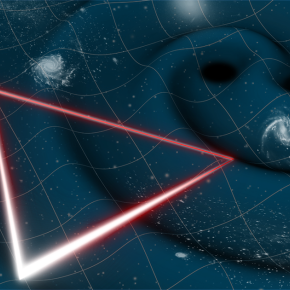ESA adopts LISA space mission to study gravitational waves
ESA adopts LISA space mission to study gravitational waves
On January 25, the Science Program Committee of the European Space Agency (ESA) gave several IN2P3 laboratories reason to rejoice: the committee announced the adoption of the LISA mission, an ambitious space project to detect gravitational waves from space. Comprising three satellites 2.5 million km apart, forming a giant laser interferometer in heliocentric orbit, the mission will measure the minute variations in space-time caused by the passage of gravitational waves. The January 25 decision gives the go-ahead for the construction of the instruments, with a view to launch in 2035-2037.
The aim of the LISA mission is to detect low-frequency gravitational waves (between 0.1 and 100 mHz), emitted by the most violent phenomena in the Universe, such as the coalescence of supermassive black holes. Its observations will provide answers to questions of fundamental physics (strong-field gravitation, physics of the primordial Universe, etc.), astrophysics (origin of black holes, formation and evolution of compact binary objects in our Galaxy, etc.) and cosmology (expansion of the Universe, nature of dark energy, etc.). The mission is scheduled to last 6 years.
The LISA project is led by an international consortium of some 200 laboratories and nearly 2,000 people. In Europe, it is coordinated by ESA and national space agencies such as CNES in France. IN2P3 has been involved in this major project since 2005, mobilizing teams from six of its laboratories: APC, CPPM, IJCLab, L2IT, IP2I and LPCC.
The Laboratoire de Physique Corpusculaire de Caen (LPC Caen) officially joined the project in 2018. The team has since been involved in the instrument’s performance model, and has developed expertise in the propagation of instrumental noise in the signal processing chain in order to estimate the impact on scientific objectives. The laboratory’s investment has been strengthened by the arrival of a doctoral student/post-doctoral fellow, enabling it to contribute to the development of algorithms for data analysis on this future mission.
Adoption of the mission is a major step towards opening a new window on the Universe.
